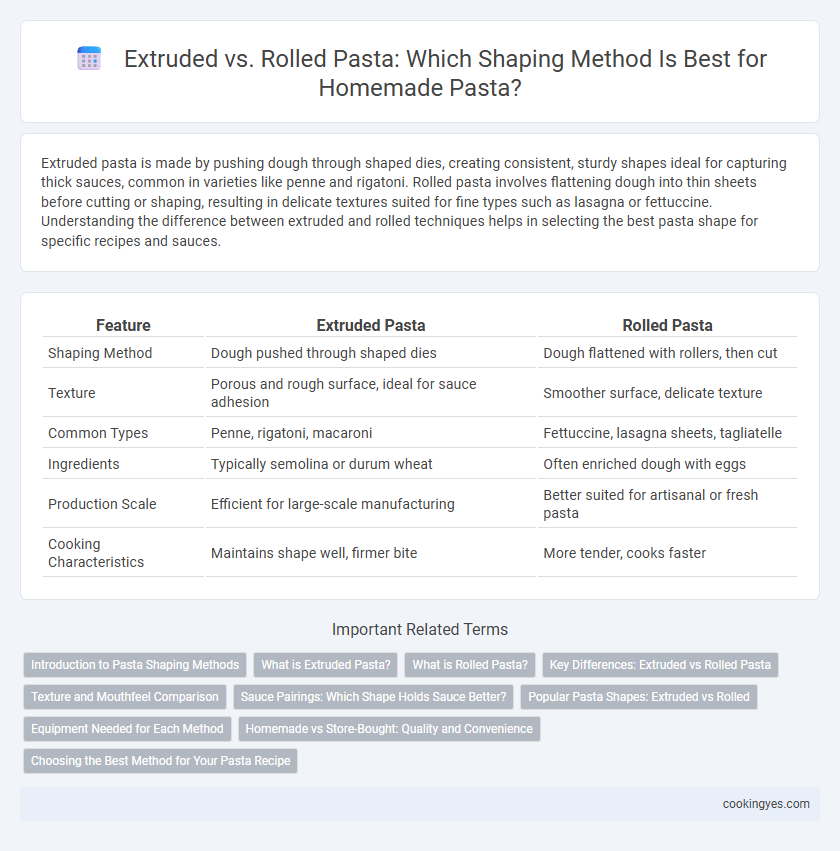Extruded pasta is made by pushing dough through shaped dies, creating consistent, sturdy shapes ideal for capturing thick sauces, common in varieties like penne and rigatoni. Rolled pasta involves flattening dough into thin sheets before cutting or shaping, resulting in delicate textures suited for fine types such as lasagna or fettuccine. Understanding the difference between extruded and rolled techniques helps in selecting the best pasta shape for specific recipes and sauces.
Table of Comparison
| Feature | Extruded Pasta | Rolled Pasta |
|---|---|---|
| Shaping Method | Dough pushed through shaped dies | Dough flattened with rollers, then cut |
| Texture | Porous and rough surface, ideal for sauce adhesion | Smoother surface, delicate texture |
| Common Types | Penne, rigatoni, macaroni | Fettuccine, lasagna sheets, tagliatelle |
| Ingredients | Typically semolina or durum wheat | Often enriched dough with eggs |
| Production Scale | Efficient for large-scale manufacturing | Better suited for artisanal or fresh pasta |
| Cooking Characteristics | Maintains shape well, firmer bite | More tender, cooks faster |
Introduction to Pasta Shaping Methods
Extruded pasta is created by forcing dough through shaped dies, producing uniform shapes like penne and rigatoni with a firm texture ideal for sauces to cling. Rolled pasta involves flattening the dough into thin sheets, which are then cut into shapes like fettuccine or lasagna, resulting in a smoother texture more suited for delicate dishes. Understanding the differences between extruded and rolled pasta helps chefs select the appropriate method based on desired texture and sauce pairing.
What is Extruded Pasta?
Extruded pasta is made by pushing dough through bronze or Teflon dies, creating shapes like penne, rigatoni, or fusilli with a rough texture that helps sauce adhere better. This method uses high-pressure extrusion to form complex shapes that are difficult to achieve with rolling, allowing for greater variety in pasta designs. The rough surface of extruded pasta also improves its ability to hold thicker sauces compared to the smooth texture of rolled pasta.
What is Rolled Pasta?
Rolled pasta is made by flattening dough through smooth rollers to create thin sheets that are subsequently cut into various shapes like fettuccine or lasagna. This method produces a tender texture ideal for delicate sauces and fillings, preserving the dough's elasticity without introducing roughness. Common rolled pasta types include tagliatelle, pappardelle, and ravioli, each benefiting from the even, thin layers achieved through the rolling process.
Key Differences: Extruded vs Rolled Pasta
Extruded pasta is shaped by forcing dough through a die, creating intricate, textured surfaces that hold sauces well, commonly seen in penne and rigatoni. Rolled pasta, produced by flattening dough sheets before cutting, results in smooth textures suited for delicate varieties like lasagna and fettuccine. The key differences lie in texture, shape complexity, and sauce adherence, influencing cooking properties and culinary applications.
Texture and Mouthfeel Comparison
Extruded pasta, shaped by forcing dough through bronze or Teflon dies, exhibits a rougher surface that better retains sauce and offers a chewier, heartier texture. Rolled pasta, produced by pressing dough through flat rollers, yields a smoother, silkier finish and a tender, delicate mouthfeel ideal for thin shapes like lasagna or fettuccine. The choice between extruded and rolled techniques directly influences pasta's bite and sauce adherence, enhancing the culinary experience.
Sauce Pairings: Which Shape Holds Sauce Better?
Extruded pasta shapes like rigatoni and penne feature ridges and hollow centers that trap thick, chunky sauces, making them ideal for meat-based or creamy sauces. Rolled pasta, such as fettuccine or lasagna sheets, has a smooth surface best suited for delicate, oil-based, or thin tomato sauces that lightly coat the strands. The choice between extruded and rolled pasta impacts sauce adhesion and overall flavor absorption, with texture playing a critical role in enhancing the dining experience.
Popular Pasta Shapes: Extruded vs Rolled
Popular pasta shapes like penne, rigatoni, and macaroni are typically extruded through bronze or Teflon dies, creating hollow tubes or ridged surfaces ideal for holding sauces. Rolled pasta, such as lasagna sheets, fettuccine, and tagliatelle, is made by flattening dough with rollers and cutting it into flat, ribbon-like shapes that cook evenly and pair well with creamy or chunky sauces. Extruded pasta offers texture variation and structural integrity, while rolled pasta emphasizes smoothness and versatility for layered or twirled dishes.
Equipment Needed for Each Method
Extruded pasta shaping requires specialized equipment such as a pasta extruder featuring interchangeable dies that mold dough through shaping plates to create various profiles like penne or macaroni. Rolled pasta involves using a dough roller or pasta machine equipped with adjustable thickness settings and cutting attachments for producing flat sheets or ribbons like fettuccine. The choice of equipment directly influences the texture and surface finish, with extruders enabling intricate shapes and rollers focusing on uniform thickness and traditional flat cuts.
Homemade vs Store-Bought: Quality and Convenience
Extruded pasta, often used in store-bought varieties, provides consistent shape and texture due to the industrial process, making it convenient for mass production. Rolled pasta, preferred in homemade recipes, delivers a delicate texture and customizable thickness that enhances flavor absorption but requires more time and skill. Homemade rolled pasta typically offers superior quality and freshness, while extruded store-bought pasta excels in convenience and shelf life.
Choosing the Best Method for Your Pasta Recipe
Extruded pasta shaping uses dies to form dough through pressure, creating shapes like penne or rigatoni ideal for holding thick sauces. Rolled pasta involves flattening dough and cutting it into thin sheets or ribbons, perfect for delicate varieties like fettuccine or lasagna. Selecting between extruded and rolled methods depends on the desired texture and sauce pairing, with extruded offering firmer, ridged surfaces and rolled providing smooth, tender results.
Extruded vs rolled for pasta shaping Infographic

 cookingyes.com
cookingyes.com